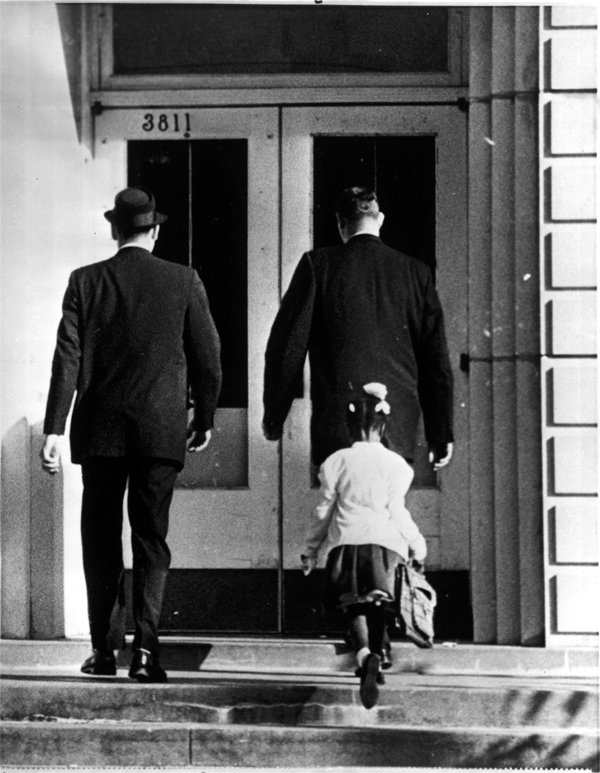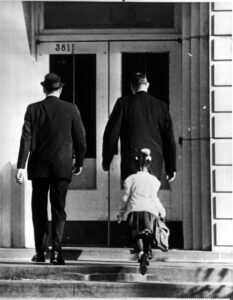New Orleans School Crisis
The integration of the Orleans Parish public schools in 1960 was the result of years of effort at the national, state, and local levels.

Courtesy of Amistad Research Center at Tulane University
Ruby Bridges Enters School, 1960. Unidentified
The New Orleans school crisis began in the summer of 1960, but the seeds for it were planted in 1954, when the US Supreme Court ruled that racially segregated public schools were unconstitutional. Faced with the order to desegregate, the New Orleans School Board—with the support of thousands of angry white parents—tried resisting, postponing, and defying the court order in every way possible. New Orleans school board members even asked the governor to intervene, hoping that he would close the state’s public schools before he would integrate them. Despite massive resistance and crowds of protestors, four African American school girls—Ruby Bridges, Leona Tate, Tessie Prevost, and Gail Etienne—attended formerly all-white schools in the fall of 1960, beginning the long journey toward the integration of New Orleans’s public schools.
Background
In the 1954 Brown v. Board of Education of Topeka, Kansas decision, the US Supreme Court found that segregation in public schools was unconstitutional and profoundly harmed African American children. Yet, the court did not insist on a specific program for the timely desegregation of the nation’s schools. Instead, it ordered local school districts to develop individual plans to desegregate “with all deliberate speed.” School districts across the South, including the Orleans Parish School District, seized upon the ambiguity of this statement and used it to justify an endless array of stall tactics. By slowing the movement toward racial integration, opponents hoped to eventually stop it completely.
In Little Rock, Arkansas, plans to integrate African American students into Central High School met with a wave of hostility that astonished the nation. In September 1957, as nine African American students prepared to attend the school, television cameras captured images of uncontrollable white mobs, which attacked journalists and police officers and threatened to spread more violence across the city. Segregationists began organizing White Citizens Councils, who often urged state governors to resist the federal mandate by taking control of local school boards. Though the federal government eventually forced Arkansas officials to comply with the law, the school closed from 1958 through 1960, inspiring protestors to try the tactic elsewhere, including New Orleans.
The Crisis in New Orleans Begins
In the spring of 1960, with the presidential election looming, federal district court Judge J. Skelly Wright ordered the Orleans Parish School to develop a legitimate plan for the desegregation of its public schools. Wright, a native New Orleanian, had ordered the desegregation of Louisiana State University’s professional schools in 1950 and its undergraduate colleges in 1953. Despite repeated protests and appeals from segregationists, Wright held firm in his insistence that a desegregation plan for New Orleans public schools be underway by September 1960. In August of that year, then governor James “Jimmie” Davis, an avowed segregationist, attempted to follow the example set in Little Rock. With legislative bill ACT 496, he officially appropriated all decision-making responsibilities for desegregation in Orleans Parish. This action sent the entire issue back to the courts, where Judge Wright ruled that Governor Davis and the legislature had unlawfully interfered in the affairs of the Orleans Parish School Board. After some pleading, Wright gave the school board more time and set November 14, 1960, as the new deadline.
Neither the mayor of New Orleans, deLesseps Morrison, nor the major local newspaper, the New Orleans Times-Picayune, helped alleviate the increasing tensions. Morrison intentionally kept the police from enforcing the court order, while the Times-Picayune called desegregation “a tragedy.” Furthermore, in the late summer of 1960, the Louisiana legislature enacted a series of blatantly divisive measures. Anyone who “contested state control over public education in Louisiana,” for instance, was subject to fines and jail time. Moreover, the governor could close any school where a riot or mob threatened to form and deny accreditation, material resources, and official recognition to any state school that integrated. Though these acts were declared unconstitutional immediately, they illustrated the extreme measures that southern legislative bodies went to derail integration.
The schools were officially desegregated on November 14, but it was a token effort. Only kindergarten and first grade were desegregated, and only four black students were selected to attend white schools. Three first-graders—Leona Tate, Tessie Prevost, and Gail Etienne—were placed in McDonogh 19 and one first-grader, Ruby Bridges, was placed in William Frantz. Both schools were located in the Ninth Ward, areas with a high population of working-class whites. No white children attended the black schools in Orleans Parish.
On November 15, the city of New Orleans was in a state of full unrest. Gangs of “cheerleaders”—young, white, working-class mothers—gathered in front of McDonogh and William Frantz to block the paths of the children and their parents heading into school. The cheerleaders also spat at the children, hurled racial invectives, slashed tires, and threatened much worse. The White Citizens Council, an ultra-segregationist and racist organization, organized a rally of 5,000 people, and encouraged white parents to defy the court order. At the rally, Leander Perez, a Plaquemines Parish political boss and vitriolic racist, infamously demanded, “Don’t wait for your daughter to be raped by these Congolese. Don’t wait until the burr-hears are forced into your schools. Do something about it now.” A race riot broke out on November 16 in front of the Orleans Parish school board building. White parents pulled their children out of both schools and, by the end of the month, fewer than ten white children attended McDonogh and William Frantz combined.
Furthermore, the numerous death threats required protection of federal marshals for all of the girls. Ruby Bridges, the lone black student at William Frantz, was particularly targeted for harassment. Between January and May 1961, Bridges was the only student at William Frantz, since white parents refused to let their children attend. The resolve of Bridges and her parents to continue, despite the torment, was captured by Norman Rockwell in his classic painting, “The Problem We All Live With.”
The Struggle for Integration Continues
In September 1961, school integration continued. President John F. Kennedy, who took office in January of that year, clearly demonstrated his sympathies for the civil rights movement and its supporters during his campaign. The 1961–1962 school year began without incident, and the entire year progressed in relative peace. In September 1962, the Catholic schools of Orleans Parish were also integrated, without much protest or disruption.
Civil rights workers had many successes in Louisiana, but it would take another ten years for the rest of the state’s public schools in Louisiana to fully integrate. The northern region of the state proved particularly resistant to change. Enforcing equal opportunity and resources remains the final chapter in Louisiana school desegregation.
